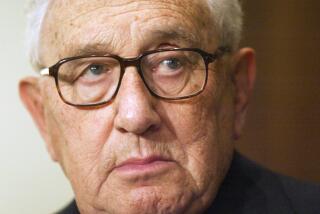U.S. Told in ’87 of Chilean Troops’ Role in Slaying
- Share via
WASHINGTON — An informant told the U.S. Embassy in Chile in 1987 that an American filmmaker killed in the tumultuous aftermath of a 1973 military coup was shot by Chilean soldiers because he was judged to be a “foreign extremist,” according to government documents made public Friday.
The source of the information was not disclosed, and the documents indicated that the embassy was unable to determine whether the information was credible.
The American was Charles Horman, whose killing in the post-coup period was the subject of a 1982 movie, “Missing.” The information received by the embassy about the case was contained in a release of 505 previously classified documents, most from State Department files.
Attending a news conference at which the files were released, Horman’s widow, Joyce, said she was disappointed that his death remains a mystery.
“We have not found the answer,” she said. “Our quest is not over.”
The embassy was told, the documents said, that Horman was arrested at his home in Santiago on Sept. 18, 1973, one week after President Salvador Allende was deposed in the coup by Gen. Augusto Pinochet. Allende is believed to have killed himself during the coup.
The Chilean source’s first contact with the embassy occurred in February 1987, more than 13 years after Horman’s death. He told the embassy that Horman was taken to the National Stadium after interrogation the day after his arrest and was shot the following evening.
An April 27, 1987, memo from the embassy in Santiago to the State Department reported that the home where Horman was staying was reputed to be housing “extremists,” and documents found there confirmed this suspicion, the informant said.
The embassy memo continues, “According to [name blacked out], the authorities at the stadium did not know that Horman was an American since his paperwork arrived after his death, and his poor knowledge of Spanish made it difficult for him to understand and answer questions. . . . The body was taken from the stadium and left at a location to create the idea that he had been killed in a firefight with the military.”
More to Read
Sign up for Essential California
The most important California stories and recommendations in your inbox every morning.
You may occasionally receive promotional content from the Los Angeles Times.













